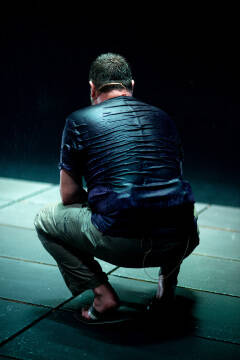Imagine letters printed in rain falling from the ceiling to the stage floor, where each drop is a pixel which forms a word only visible for a few seconds. That's what the 'digital theatrical rain printer' did in its premier in OPEK, Leuven. Performing arts and technology meet each other in this cooperation between Nieuwstedelijk and KU Leuven's e-Media Research Lab. By building a machine which combines the characteristics of a regular rain machine and a printer, the machine literally makes it rain words.
"This clear cross over between creativity and technology is an ambitious project with a clear return for both partners. It also shows that high-tech and creativity can create beautiful projects", the judges mentioned last year when they announced the rain printer as one of the winners of the Cross Over Contest by Leuven MindGate.
Stijn Devillé from Nieuwstedelijk was grateful for the prize. "Without the Leuven MindGate network, I would have never even begun with this type of cross over. I'm very happy to have met such an enthusiastic partner as Luc Geurts from KU Leuven. The project also shows that technology is much more than just mathematics and funtionality; it is also capable to move and affect people emotionally."
written and directed
Stijn Devillé & Tom Van Bauwel & Sara Vertongen
child's voice
Marion De Schepper
music
Gerrit Valckenaers & Geert Waegeman
Video
Walter Verdin
light design
Mark Van Denesse light design
dramaturgy
Els Theunis
technical coordination
Kishan Singh
development rain printer
Arne Broeders & Wouter Driessens, prof. Luc Geurts
technicians
Viktor Thys, Thomas Verachtert, Peter Lauwers, Tom Buys, Bregt Janssen
production
Ellen Haesevoets, Greet Van Poeck, Thomas Verachtert & Miek Scheers (internship)
sound design
Stefan De Reese & Tom Buys
costume design
Veerle Hasselman
kunstenvliegmerk stage design
Benoit Aigret, Andreas Ketels
technical support
Berne Dries, Vic Van den Bossche, Willem Rys, Joffrey Guillaume, Brian Doms, Anton Spiessens, Tibo Spiessens, Jari Abeloos, Nils Janssens, Jelle De Hertog, Thijs Deroost, Glenn Loddewykx, Danny Depoorter
a production of
Het nieuwstedelijk
coproduction
C-mine cultuurcentrum
in collaboration with
e-Media Research Lab KU Leuven
with the support of
Leuven MindGate Crossover Contest and the Flemish Government and the support of het Vlaams Fonds voor de Letteren.
with the support of
the Tax Shelter incentive of the Belgian Government and Gallop Tax Shelter
On creating feeling machines
by Stijn Devillé
---------------------------
Jacob McPherson for THE WORD magazine
Eight years ago, my daughter fell down a staircase, leaving her seemingly lifeless. This encounter left me flooded with conflicting emotions – anger, sadness, fear. No one wants to go through losing someone close, especially right in front of your eyes. After rushing her to the hospital, she thankfully recovered and survived the ordeal. I was immensely affected from this notion of grieving, but knew my pain wasn’t as deep as those who have actually endured a loss. The biggest challenge for me then was in learning how to incorporate this personal experience into something that would feed genuine to the public. The incident remained fresh in my body and mind and became a focal point for emotional discovery. Coincidentally, at a reception party, I found myself speaking with a couple who had experienced the death of their son. While talking with them, and hearing about their coping process, it became clear that societal expectations play a role in how people mourn. On this note, it was interesting to discover that the grieving process created a closer bond for the couple. The complex array of feelings they expressed reflected what I went through myself. I also met Gilbert Declerck, co-founder of imec at that very same party, and discussed with him the immense pressure Europe faces in competing with other global regions, similarly to Asia. Such a fast-paced society trickles down to other aspects, like the rate at which we are expected to get over the loss of a loved one. Further speeding up daily life is the integration of technology. This aspect of modern society also negatively impacts privacy, personal time, and an overall sense of fulfilment. When an unexpected event like death occurs, these factors become magnified. It was clear that I needed to create a story about how a modern, urban, hard-working, technologically “plugged in” family handles mourning. Following guidelines from The Wooster Group’s cofounder Elizabeth LeCompte on what makes a good theatre piece, my latest production Gesprek Met De Regen incorporates societal analysis, chronicle (space & time), and form. It’s also worth emphasising how the dichotomy of form and content became an integral part of this production. There was a tension between what was drawn from reality and how the story came to life on stage. Drawing on a personal experience, it was important to maintain this connection while creating a message with universal impact. Although Gesprek Met De Regen is entirely fictitious, its roots and inspiration are sourced from real life – including the rain machine. While writing the story and conducting some initial research, I stumbled upon a similar machine on YouTube. Although it was used for marketing purposes, I wondered how the device might print poetic words from water, and so I approached Luc Geurts, head of the e-Media Research Lab of the KULeuven about building a similar rain machine. Since they regularly support the artistic community, developing a mechanical device capable of expressing human emotions was a natural fit for the department. This element of rain became essential for the performance. Associated with grief, it represents life coming to a total standstill.
